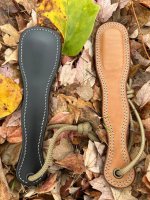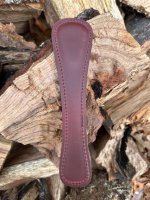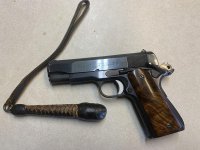Faulkner
Member
"A blackjack weapon or sap refers to a group of weapons that are short, concealable, and weighted (usually filled with lead powder, molded lead clay, or lead shot) to constitute an effective bludgeoning device. The terminology used to refer to these weapons can be very imprecise depending on the period."
I started my LE career in 1995 and saps, as we call them locally, were already obsolete as a LE tool by then. I recall seeing a couple of detectives who each had one, as more of a show piece, that they kept in their desk drawer but I never saw one in the field. Billy clubs were also gone from patrol cars in our area by the time I went out on patrol. I was trained at the academy on OC spray and ASP collapsible batons and I still carry both on my duty belt. Although it's come in handy many times I've never used my ASP on a person.
Even so, I was always fascinated by saps. I came upon a fellow who had a few for sale at a gun show that were made by Foster Industries and was so impressed with the quality I purchased a couple of them, I think they'll make great paper weights.
The black one on the left is a Model 36 that is 9 3/4 inches, 20 oz weight and the handle is sprung. It's quite heavy.
The one on the right is the Door Man model in 4 ply oiled steer hide, 10 1/2 inches long, 15 oz with a springless handle.

I started my LE career in 1995 and saps, as we call them locally, were already obsolete as a LE tool by then. I recall seeing a couple of detectives who each had one, as more of a show piece, that they kept in their desk drawer but I never saw one in the field. Billy clubs were also gone from patrol cars in our area by the time I went out on patrol. I was trained at the academy on OC spray and ASP collapsible batons and I still carry both on my duty belt. Although it's come in handy many times I've never used my ASP on a person.
Even so, I was always fascinated by saps. I came upon a fellow who had a few for sale at a gun show that were made by Foster Industries and was so impressed with the quality I purchased a couple of them, I think they'll make great paper weights.
The black one on the left is a Model 36 that is 9 3/4 inches, 20 oz weight and the handle is sprung. It's quite heavy.
The one on the right is the Door Man model in 4 ply oiled steer hide, 10 1/2 inches long, 15 oz with a springless handle.
Attachments
Last edited:



